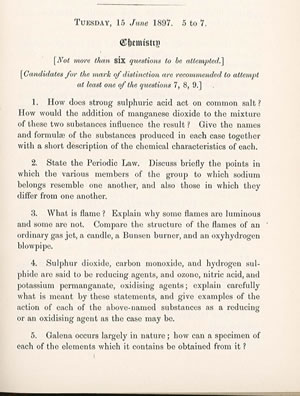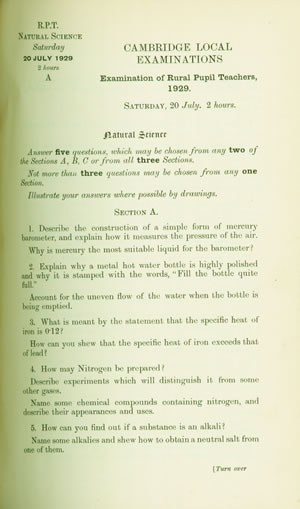In celebration of the International Day of Women and Girls in Science - a day which recognises the critical role women and girls play in science and technology - Cambridge Assessment’s Group Archivist, Gillian Cooke, looks back at science exams for female candidates.
Low take up of Physics and Chemistry by girls isn't a new phenomenon
Low take up of Physics and Chemistry by girls isn’t a new phenomenon; female candidates accounted for only around ten percent of O Level Physics candidates in 1953 and slightly more than twenty percent for Chemistry. Biology fared very differently, and more than three quarters of the candidates for this subject were female. But before the introduction of single subject qualifications, candidates had to pass in a range of subjects to gain a qualification, so did this mean that the take up of science subjects was more equitable then?

Although School Certificate regulations meant that candidates had to pass subjects from different groups, all the Sciences were in one group and included not only Physics and Chemistry (and a subject called Physics-with-Chemistry), but also Biology, Botany and General Science. Statistics from 1930 to 1950 show that the principal science subjects chosen by boys and girls consistently followed predictable lines. General Science, however, rose in popularity with fairly even selection by all candidates. At Higher School Certificate level, candidates could also choose Zoology and the Natural Science of Animals and these subjects, too, attracted similar numbers of entries from both boys and girls.
Science exams for Girls and Women only
There were science exams set specifically for female candidates. The earliest of these were the Higher Examinations which were set up in 1869 for women over the age of eighteen. Although these exams were later available to men, the candidature remained predominantly female, reinforced by acceptance of the qualification as matriculation for entry to the female only undergraduate colleges at Cambridge. With an entry fee of 40 shillings - equivalent to two weeks wages of a skilled tradesman - the qualification attracted upper middle-class women intending to become academics or teachers.
As with the School Certificate, candidates for the Highers had to pass in a range of subjects from certain groups, and the sciences were all in Group E. The statistics make predictable reading. Group E consistently has the fewest candidates, attracting just 62 out of a total of 875 candidates for the examinations of 1897. It seems that the women preferred the other options – Latin and Modern Languages, Political Economy and History or Religious Knowledge. A reason for the low take-up of sciences could have been the availability of good quality teaching and practical equipment. A recurring theme from the Minutes of the Higher Local Examinations show that the examination organisers had difficulties finding centres to host Chemistry practical exams. An alternative to the practical paper was set, but eventually practical examinations could only be accommodated in Cambridge - a particular challenge to the Cambridge ‘Locals’ whose name reflected the pioneering ethos of providing examinations to candidates in centres near to their homes.

Rural Pupil Teacher (RPT) Exams were introduced in 1927. These were aimed at training teachers who were interested in ‘country life and occupations’, and, launched in collaboration with the Board of Education, they were pitched at rural teachers and teaching assistants. Candidates had to be over seventeen, so it provided an opportunity for those already in employment to gain a qualification. As with the Highers, the candidates were mostly female - in 1929 there were forty-eight female candidates out of a total of fifty-four. And, for this qualification, there was no escaping science as all candidates had to pass in English, Elementary Maths and Natural Sciences. A good start, until a glance at the non-compulsory subjects - History, Geography, a foreign language, Art, Music, Gardening, Handicraft, Housecraft and Needlework – reveals no further science!
Another female teaching qualification was at Homerton Teacher Training College for which UCLES (Cambridge Assessment) set the final exams from 1929 to 1951. In 1935 the question papers for this qualification were English, Maths, Principles of Teaching, History, Geography, French, Music, Drawing, Physical Training, Gardening, Hygiene, Individual Handwork, and General Biology. By 1950 the curriculum also included Rural Science and Social Science so perhaps the ‘science’ we are looking for is elsewhere? Certainly, in the earliest question papers of the nineteenth century (when the exams were available only to boys) there is plenty of ‘science,’ albeit with unfamiliar names; there is Chemistry but also Heat, Electricity, Magnetism, Acoustics and Physical Optics, Hydrostatics and Mechanism.
Science in other subjects
There were some practical subjects which included science-type questions, however. Hygiene or Health Education featured widely before 1950 and these subjects covered areas such as transmission of disease, air and water quality, and even alcoholism, which, before the establishment of the National Health Service, would have been highly relevant to everyday life. By 1930, however, school certificate Hygiene was replaced by Housecraft – as exclusive to girls as Handicraft was to boys – with sections on cookery, laundrywork and housewifery.
By 1930, however, school certificate Hygiene was replaced by Housecraft – as exclusive to girls as Handicraft was to boys - with sections on cookery, laundrywork and housewifery.
When the GCE O level exams were introduced in 1951 Housecraft disappeared and Cookery and Needlework became separate O level subjects. With its heavy focus on health and nutrition, Cookery was more than is indicated by the title but with references to housewives, businessmen, typists, schoolgirls and schoolboys there is no denying its gender bias. So, looking again at the O level statistics of 1953, despite the popularity of Biology amongst girls, there is also Cookery at the bottom of the table, and these stats show that Cookery attracted more female candidates than for Physics, Chemistry and Physics-with-Chemistry added together!